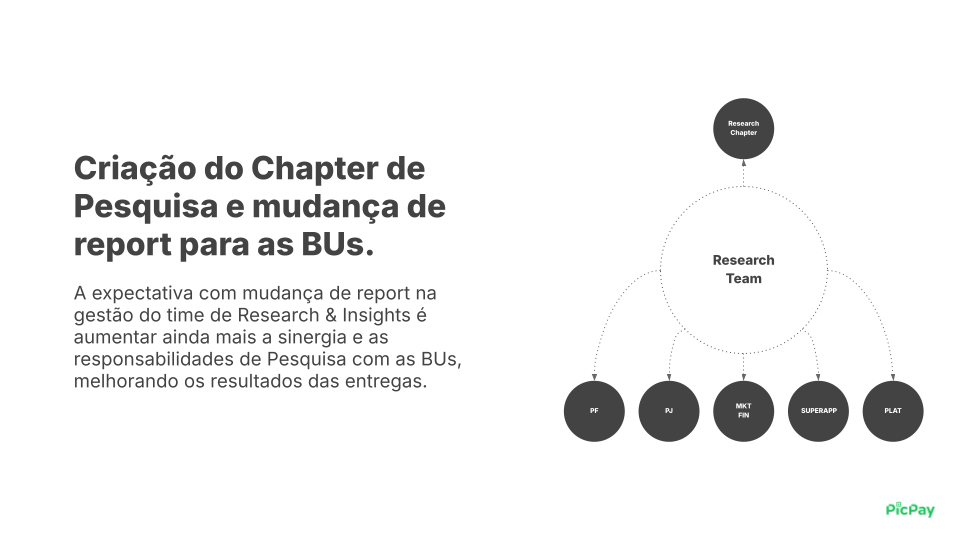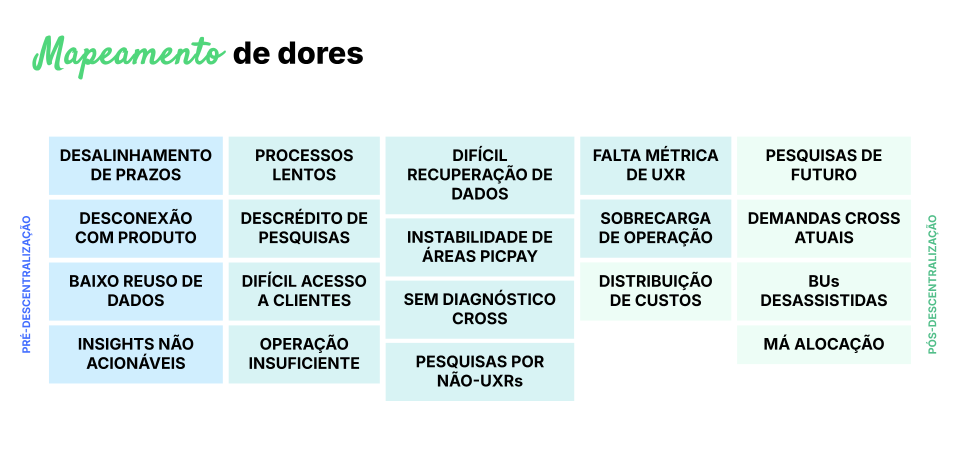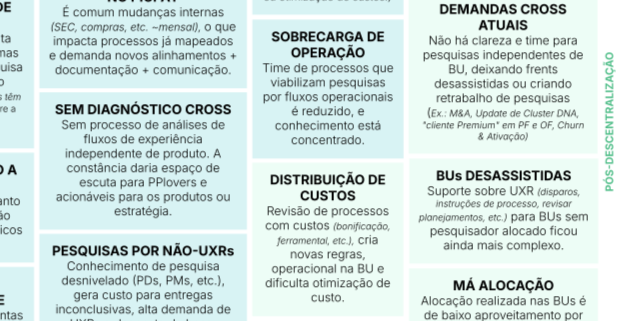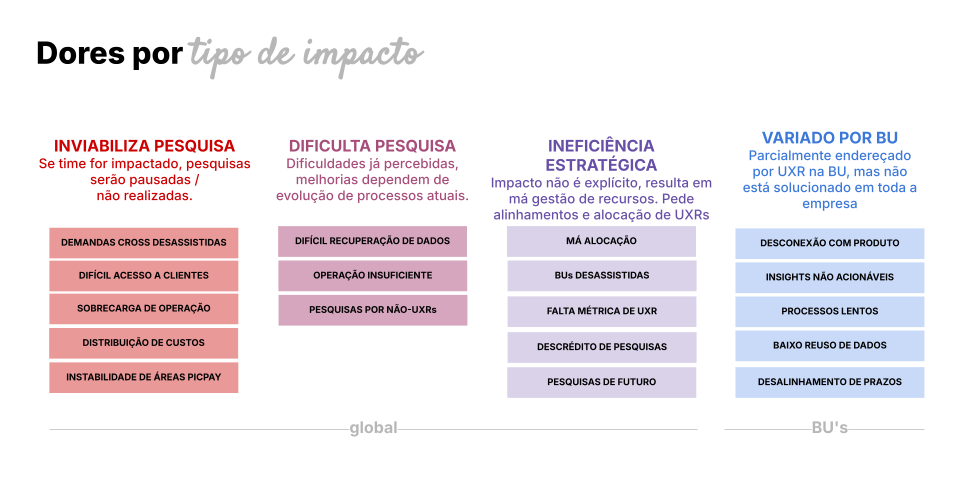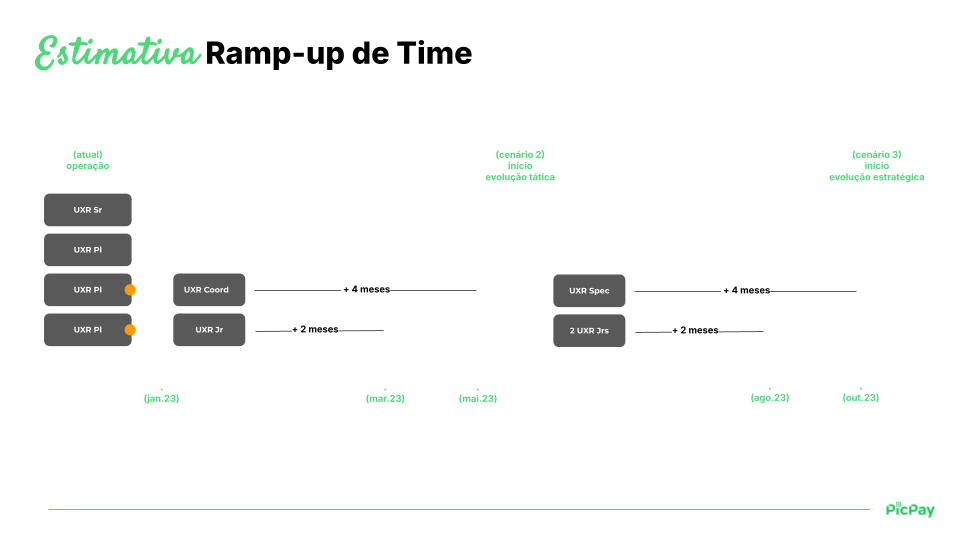Restructuring Research After Decentralization
Redefined Research operations post-decentralization, aligning roles, responsibilities, and supporting hiring, allocation, and structure decisions across business units from PicPay.
Context
When I joined PicPay, the UX Research team was undergoing a major structural transition. Previously centralized, the team was reorganized into a decentralized model due to several operational challenges and the need for closer integration with product squads. Under the new structure, researchers were directly managed by UX Design leaders within each business unit, while I assumed the role of technical leader for the Research Chapter Operations discipline.
Challenge
The shift to a decentralized model introduced new complexities. Without clear responsibilities or aligned expectations, both researchers and their new managers struggled to navigate their roles effectively. At the same time, long-standing operational issues persisted — including inefficient resource allocation and limited access to users for research.
My mission was to ensure cohesion across the discipline, safeguard methodological quality, and reestablish the research team’s ability to support business decisions effectively.
discovery
To address these challenges, I conducted a comprehensive diagnostic of the research function, engaging with the current Research Team, UX Design Leaders (who had become responsible for leading the researchers), and key executive stakeholders.
This assessment enabled the identification of pain points across the organization. Some of these issues had been mitigated through the decentralization process, others persisted, and new challenges emerged as a result of this structural change.
pain points
The same topics emerged according to each Business Unit’s level of maturity regarding research. I considered these as a secondary focus of the activities, given that my work would follow a consultative approach.
The issues impacting the organization as a whole were organized into three levels:
1. Critical operational blockers (issues that prevented research from taking place):
Lack of access to users for recruitment and interviews.
Undefined ownership of the research budget and vendor engagement process.
Absence of standardized research operations.
2. Execution inefficiencies (issues that made research more difficult to conduct):
Difficulty retrieving and reusing past research insights.
Decline in study quality when led by non-research specialists.
Unclear ownership and collaboration practices.
3. Strategic misalignments (issues that reduced impact):
Mismatch between researcher profiles and assigned projects.
Business units lacking dedicated research support.
Limited visibility into research demand and resource availability.
Actions Taken
1 . Development of a prioritization matrix to align leadership on critical short- and mid-term actions:
For each identified pain point, I connected a potential solution, providing an overview of which initiatives would be most effective or address multiple issues simultaneously.
I highlighted the most relevant points to be addressed first, emphasizing the prioritized topics for each group and the reasons for their urgency.
Finally, I defined a roadmap to rebuild efficient, scalable, and impactful research operations, based on a gradual team expansion approach.
2 . Execution of a company-wide communication and alignment initiative with all Business Unit leaders who had direct or indirect responsibility for UX researchers:
Developed and presented clear materials outlining the new division of responsibilities between Research Operations (my team), UX Researchers, and their functional managers.
Clarified expectations for each researcher role by seniority, defining what leadership teams should expect and how to provide appropriate support.
Recommended optimal team structures for each Business Unit, according to its size, product maturity, and research demand.
Established direct collaboration channels for hiring and team growth, supporting BU leaders with team sizing, budget alignment, internal researcher reallocation, technical interviews, and candidate evaluations to ensure high-quality recruitment decisions.
Strategic Outcomes
Organizational clarity: Defined roles, responsibilities, and expectations post-decentralization.
Stronger partnerships: Built trusted relationships between Research Ops and BU leaders for aligned hiring, growth, and execution strategies.
Increased efficiency: Removed blockers to enable faster, higher-quality research execution.
